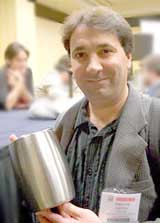 |
 |
 |
|
News & Notices
News From:
Commissions
Conference & Stage Expo
For the Record
|
The Real Meaning
Of Sound Pressure What do stainless steel water cooler rings, backed up traffic, hotel room towel bars, rings of keys, and public water fountains have in common? All have been used as primary sources for sounds by designers participating in Guerilla Sound Design: The Three Hour Challenge. This year's session will start promptly at 6 p.m. on Wednesday, March 14 in Room 39 of the Phoenix Convention Center. Playing to a standing room crowd during the 46th Annual Conference & Stage Expo in Louisville last year, six sound designers (including the first two-person sound design team in the competition necessitated by the early demise of one participant's laptop) took part in the second annual Challenge. Session chair Bill Liotta, always one to push the envelope just a little further, engaged the services of Bill Walters, an experimental director and professor at Hunter College in New York City. Professor Walters enlisted two volunteer students attending the conference, Nicole Ladger from Boise State University, and Ola K from Marshall University, and created a movement and text performance to accompany a projected video background. Taking up the challenge in Louisville were David Budries (Yale), Jason Romney (North Carolina School of the Arts), Drew Dalzell (professional sound designer and owner of Wasted Monkey Sound), Ron Shoemaker (sound design student at Purdue), and the team of John Story and Megan Henniger (UKC). So, what is meant by a "three hour challenge?" Sound designers are signed up for the event in advance, but they are told only that they must arrive with a laptop and sound editing program. They are not allowed to make use of pre-existing sound files or recorded media. Literally three hours ahead of the public presentation, they are herded into a room and given the parameters of the event -- in Louisville they observed the video and the movement/text performance for the first time. Then they spread out using microphones, laptops, sound cards to gather elements, and digital audio editors to create a soundscore to support and enhance the presentation they observed. Much to the delight of the enthusiastic audience, the designers then connected their laptops to the high end sound system (provided courtesy of d&b audiotechnik) in the Sound Commission's main presentation room, and performed their compositions as Nicole and Ola performed the piece. Each designer then described their process, both in terms of how they found a way into the aesthetic of the piece and the details of what they used to create and manipulate the sounds. As discovered in Toronto with the first Guerilla Sound Design Challenge, it is fascinating to observe how each designer approaches the project, and to see how each approach works with the piece. Mr. Walters noted that he found each designer's work to take the piece in a different direction, but that all of them were potentially workable. What is ahead for Phoenix? Just as this year's designers are in the dark (or would that be "in the quiet"?) about what to expect, so are all who will have the chance to see the Challenge unfold for the third year. The constants are that the designers and design teams will have no preconceived idea what they will encounter, and they will have just three hours to move from initial meeting to finished performance. Those who want to be part of the historic Third Annual Guerilla Sound Design: The Three Hour Challenge in Phoenix should make a point of getting there early. |

Session Chair Bill Liotta displays the most popular composition tool for the 2006 Guerilla Sound Design Three Hour Challenge. |
United States Institute for Theatre Technology, Inc.:
© 2007 Volume XLVII, Number 3